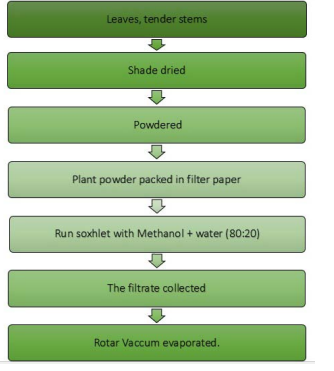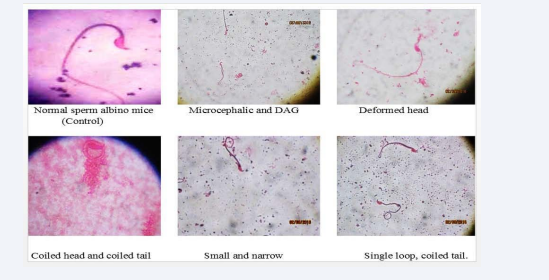In vivo Protective Role of Amaranthus viridis Extract and Direct Folate Treatment on the Sperms of Swiss Albino Mice
- 1. Department of Zoology, Sarojini Naidu Vanita Maha Vidyalaya, India
- 2. Deparment of Botany, Osmania University, India
- 3. Department of Genetics and Molecular Medicine, Vasavi Medical Research Center, India
- 4. Molecular Entomology Lab, Department of Zoology, Osmania University, Telangana, India
- 5. ICRISAT Development Centre, ICRISAT, Telangana, India
- 6. Genetics Unit, Hansgene Cancer Foundation, Hyderabad, India
ABSTRACT
Background: Synthetic drugs are available for treating infertility in men caused by various reasons as in use of anti-folates, poor health and environment etc. Plant supplements are preferred over chemicals due to lesser side effects and replenishment of the body through natural dietary resources
Methods: Albino mice (Mus musculus) have been used as animal models for studying the benefits of Amaranthus leaf extract (Soxhlet extraction) and folate on the methotrexate dampened sperm conditions affecting the male fertility in mice.
Results: Methotrexate-exposed mice with abnormal sperm morphology (p=0.034), reduced motility (p=<0.0001), dead sperms (p=<0.0003) indicated significant damage induced by methotrexate. Folate and Amaranthus treatment reduced damage (pFA=0.30 and pAE=0.37). Mice showed significantly improved mean values, and drastic improvement in sperm motility (pFA = 0.0053, pAE = 0.0024), reduction in dead sperms (pFA = 0.0059 and pAE =0.0092), and no significant impact on the head morphology (pFA 0.38, pAE =0.15).
Conclusion: In our study we have observed that Folate and Amaranthus extract have noticeably contributed to improvement of sperm morphology in male mice. Further analysis can be done for evaluating its potential in treating fertility related complications in men.
KEYWORDS
Infertility ;Methotrexate ;Folate ; Amaranthus viridis extract.
CITATION
Devi S, Amballa H, Khan FA, Chaudhury S, Mohan V (2018) In vivo Protective Role of Amaranthus viridis Extract and Direct Folate Treatment on the Sperms of Swiss Albino Mice Ann Clin Exp Metabol 3(1): 1027.
INTRODUCTION
Couples visiting fertility centers are treated for sperm abnormalities owing to the inability to conceive due to poor sperm count/quality. Identifying factors contributing to poor semen should be combined with adopting a healthy lifestyle to help in sperm health recovery and increased pregnancy chances. Amaranthus viridis and folate treatment was used in mice administered methotrexate known for its detrimental effects on fertility, to investigate their benefits in improving sperm quality. The idea was to identify an agent that can be easily incorporated into our diet that can improve sperm performance and benefit couples visiting fertility centers while planning a pregnancy
In humans, a sperm count of 20 million/ml and above with more than 60% motility is considered adequate to confer a chance of pregnancy in the couple with a normal healthy female partner. In addition, the colour, fructose levels, pH, liquefaction are indicator tests for normal sperm quality. Low sperm count is an indication of decreased fertility as more and more germ cells are lost during spermatogenesis [1,2]. Abnormal sperms may be due to external factors like kidney and liver disorders, unhealthy lifestyle and work atmosphere, smoking etc [3,4]. It is essential to evaluate sperm head morphology in sub-fertile men especially where the couple opts to use assisted reproductive techniques (ART) to conceive.
Studies in the past have associated higher folate levels with lower frequencies of abnormal sperms and depleted sperm count. Folic acid is a type of Vitamin B- B9 an essential nutritional requirement for the body as it participates in de novo synthesis of DNA in mammalian cells and is crucial to many metabolic pathways which include histidine cycle, serine and glycine cycle, methionine cycle. It also helps maintain erythropoiesis, manages homocysteine levels in blood, inter-conversion of amino acids and is essential in thymidylate and purine synthesis [5]. Zinc, a micronutrient, showed significant association with increased sperm concentration in sub-fertile males (18.5 x106 cells/ml [p=0.02]) in a study conducted to evaluate the effects of folate and zinc on male fertility [6].
Deficiency in folic acid has been associated with decreased sperm count in mice. Folic acid deficiency can arise due to various reasons like cancer, poor dietary intake and use of anti-folates such as methotrexate which affects folic acid metabolism as it has a higher affinity for DHFR (Dihydrofolate reductase), resulting in irreversible inhibition of the enzyme [7].
A study by Young et al., found that lower dietary intake of antioxidants such as vitamin C and increased levels of oxidizing agents in semen have been associated with decreased motility, count, viability and abnormal morphology in both human and animal sperm [8].
Anti-folates affect all mammalian cells because they inhibit folate metabolism, for this reason they have been under scanner for causing possible damage to sperm cells in mammals [9]. Methotrexate being an anti-folate, is often used as a drug to treat diseases such as cancer and autoimmune diseases such as rheumatoid arthritis [10]. The mechanism of action of this drug is inhibition of DNA, RNA and protein synthesis by binding to DHFR enzyme which catalyzes the reduction of dihydrofolate (inactive state) to tetrahydrofolate (active state) which participates in activation of folate dependent enzymes required for DNA synthesis and methylation [11]. Methotrexate has been associated with declined fertility in mice which is seen as a result of aberrant sperm morphology i.e. abnormal head and tail which affects the sperm motility and contributes to decrease in the sperm count [12].
Amaranthus viridis also known as green amaranth is an annual herb 75-100 cm in height, numerous branches, the leaves are slender glabrous and ovate, having long petiole [13]. This herb has high nutritional value and is used for treating inflammation, boils and abscesses and purification of blood. The plant contains essential nutrients and has good levels of calcium, iron, beta carotene, folic acid and ascorbic acid [14]. The leaf extract of Amaranthus viridis has been used to study its anti-oxidative properties and the alkaloids were found to be pharmacologically active and potential promoter of oxidation [15-17]. A study done to evaluate nutritional and mineral compositions of green leafy vegetables in Assam (India) showed high levels of zinc content in A. viridis (6.50mg/100g) [18].
We conducted a mice study aimed at finding out whether increased folic acid intake or use of natural plant source such as Amaranthus viridis extract can be used as a dietary supplement to reduce or prevent sperm anomalies on undergoing treatment with anti-folate drug such as methotrexate which is known to cause sperm depletion and dampen the sperm motility due to irregular head and tail morphology conditions in mice.
MATERIALS AND METHODS
Ethics approval-The ethical standards of experiments were in accordance with the guidelines provided by the CPCSEA (Reg # 1754/PO/RC/S/14/CPCSEA)
STUDY DESIGN
Plant Extract
Amaranthus viridis (Figure 1)
Figure 1 Amaranthus viridis plant
is commonly known as Thotakura in Telugu, India. A. viridis seed’s were purchased from local market, Ranga Reddy district, Telangana, India. The plants were grown in black soil with good agricultural practices. The plants were authenticated by T. Sudha Rani, Taxonomist-Sarojini Naidu Vanita Maha Vidyalaya in Hyderabad-India. After 30-45 days of vegetative growth, the stem and the leaves were used for extraction. The leaves were washed in distilled water for two or three times and shade dried. The dried leaves and the stem were coarsely crushed, powdered and stored in air tight container for further use. The sample was extracted using methanol (Hi Media) and water (80:20) with the help of Soxhlet apparatus in three replicates. The extract was further concentrated using the rotary vacuum evaporator under reduced pressure and stored at 4° C in a refrigerator.
In vitro studies
Healthy Albino mice (Mus musculus) around eight to ten (8- 10) weeks old males, weighing 21 to 28 grams were procured and maintained in CPCSEA approved animal breeder, (Reg # 1754/ PO/RC/S/14/CPCSEA) and housed in a clean room. The mice were kept at standard temperature of 22 °C (± 3 C) with 50% to 70% relative humidity, light and dark (12h) photoperiod was maintained. The feed used was commercially available pellets from Hindustan lever limited, Mumbai and autoclaved Milli Q water.
The mice were divided into four groups each with five animals. In each cage a minimum of two animals were kept.
Dose
Folic acid (Hi Media) 400µg per day is the daily requirement for teens and adults. In the experiment 250µg was given per dose.
Group-1: Methotrexate of 0.300mg/kg per mice, once a week for three weeks.
Group-2: Methotrexate and folic acid 250µg per mice, once a week for three weeks.
Group-3: Methotrexate and Amaranthus Extract 250µg per mice, once a week for three weeks.
Group-4: The control animals were given distilled water 2ml per mice, once a week for three weeks.
The albino mice were treated with above vehicles and the animals were examined for clinical manifestations. The mice were sacrificed by cervical dislocation and the cauda epididymis was collected for sperms. From each group two mice were used, one mice was used for checking abnormalities and other for sperm count. The epididymis was minced in 0.7% saline, large fragments were removed and centrifuged for five minutes at 2000 rpm. Then the supernatant was obtained and sperm count was performed using Neubauer chamber. Similarly, one mouse was used from each group for checking sperm head abnormalities. After collecting the cauda epididymis it was minced in sodium citrate (2.2%) centrifuged at 1000 rpm for five minutes. Smears were prepared after staining in Eosin Y for observation under microscope (Figure 2).
Figure 2 The abnormal sperms with head and tail defects in methotrexate treated mice.
The methotrexate in the present study induced changes in the morphology of the sperm. The shape of the sperm plays an important role in analyzing the morphological abnormalities.
Table 1: Nutritional composition of Amaranthus viridis:
| Chemical composition | (Per 100 g of edible portion). |
|---|---|
| Water | 88.9 |
| Energy (Kcal) | 18 |
| Protein (mg) | 3.5 |
| Fat (g) | 0.3 |
| CHO (g) | 0.3 |
| Fibre (g) | 2.6 |
| Ca (mg) | 270 |
| Fe (mg) | 130 |
| P (mg) | 65 |
| Mg (mg) | 3.0 |
| Carotene µg | 1725 |
| Thiamine mg | 0.07 |
| Riboflavin mg | 0.22 |
| Niacin mg | 0.7 |
| Folic acid mg | 85 |
| Ascorbic acid mg | 42 |
Sources: Holland et al., 1991; Leung et al., 1968
It has been observed that the sperm abnormalities occurred in MTX-treated mice. After three weeks of treatment there was some difference seen in the head morphology or the tail region. The head region varied in shapes and could be microcephalic or macrocephalic, pyriform, amorphous or elongated.
The MTX + folic acid treated animals mostly showed normal features of head shape and tail than MTX primed alone.
The MTX + Amaranthus extract treated animals showed a decrease in the head morphological deformations when compared to MTX alone.
Med Calc version 11.5.1.0 was used for performing Odds ratio test (i) to assess damage between Control and MTX treated groups and (ii) to assess the damage in groups supplemented with Folic Acid (FA) and Amaranthus Extract (AE) as compared to the MTX treated groups.
I. Damage induced by methotrexate on the sperm head and tail morphology is significant at p=0.034 when compared to the controls (Table 2 (a) and 2 (b)).
Table 2 (a): Damage induced by methotrexate on the sperm head and tail morphology
|
Dose |
No. of sperms examined |
No. of abnormal Sperms |
Mean %.. |
Amorphous |
Pyriform |
Elongate |
Microcephalic |
Macrocephalic |
Tail Abnormalities |
|---|---|---|---|---|---|---|---|---|---|
|
Control |
2000 |
90 |
4.5 |
40 |
- |
- |
18 |
23 |
09 |
|
MTX |
2000 |
120 |
6 |
52 |
7 |
14 |
20 |
7 |
20 |
|
MTX+FA |
2000 |
105 |
5.25 |
43 |
09 |
14 |
14 |
15 |
10 |
|
MTX+AE |
2000 |
107 |
5.35 |
41 |
08 |
18 |
13 |
17 |
10 |
Table 2 (b): Damage induced by methotrexate on the sperm head and tail morphology is significant at p=0.034.
| Dose | No. of sperms examined | No. of abnormal Sperms | Odds ratio (95% CI) | p value |
|---|---|---|---|---|
| Control | 2000 | 90 | - | .. |
| MTX | 2000 | 120 | 1.35 (1.02-1.79) | 0.034 |
| MTX +FA | 2000 | 105 | 1.66 (0.66-1.13) | 0.30 |
| MTX+AE | 2000 | 107 | 0.88 (0.67-1.15) | 0.37 |
II. Number of sperms with reduced motility (p=0.0001), dead sperms (p=0.0003) and abnormal head morphology (p=0.015) showing highly significant damaging effect of methotrexate on mice fertility Table 2 (c).
Table 2 (c): Sperm Motility, dead and abnormal sperms: Sperm Motility,
| Groups | Sperm motility Mean% | Odds ratio 95% CI | P value | Dead sperms Mean % | Odds ratio 95% CI | P value | Sperm-head abnormalities Mean % | Odds ratio 95% CI | P value |
|---|---|---|---|---|---|---|---|---|---|
| Control | 180/200= 90 | ... | .... | 14/200 = 7 | ... | .... | 8/200 = 4 | .... | ..... |
| MTX | 140/200 =70 | 3.85 (2.22-6.66) | 0.0001 | 40/200 = 20 | 3.32 (1.74-6.32) | 0.0003 | 21/200 = 10.5 | 2.81(1.21- 6.5) | 0.015 |
| MTX + FA | 164/200 =82 | 0.51 (0.31-0.82) | 0.0053 | 20/200 = 10 | 0.44 (0.24-0.79) | 0.0059 | 16/200 = 8 | 0.74 (0.37-1.46) | 0.38 |
| MTX + AE | 166/200 =83 | 0.47 (0.29-0.77) | 0.0024 | 21/200 = 10.5 | 0.46 (0.26-0.82) | 0.0092 | 13/200 = 6.5 | 0.59 (0.28-1.21) | 0.15 |
III. The number of abnormal sperms decreased in FA and AE treated mice. Sperms in the AE extract and FA treated mice showed significantly improved mean values; FA and AE supplemented groups showed drastic improvement in motility (pFA = 0.0053, pAE = 0.0024), and reduction in number of dead sperms (pFA = 0.0059 and pAE =0.0092), whereas it did not show a great impact on the head morphology (pFA 0.38, pAE =0.15).
IV. Effect of FA and AE on head morphology in methotrexate exposed cells: Reduced damage, Odds ratio not very significant at pFA=0.30 and pAE=0.37.
The abnormal sperms with head or tail defects are as shown in Figure 2.
DISCUSSION
According to Lock and Soares (1980) sperm evaluation is said to provide a quantitative measure for identifying genetic damage via estimating the count, morphology and motility in addition to other aspects of the seminal fluid [19]. Dietary corrections may be found beneficial in providing respite to individuals having unsuccessful attempts in conception. It has been found that dietary intake of vitamin C improved sperm count, vitamin E intake improved total progressively motile sperms, and betacarotene uptake improved both sperm count and motility. A. viridis, a natural source of folate has become a point of interest because it could prevent or reverse sterility in men undergoing methotrexate treatment and also in the other cases with general folate insufficiency
Methotrexate is an anti-metabolite agent that is used in treatment of neoplastic disorders and other ailments like rheumatoid arthritis etc. Exposed individuals reported a decrease in sperm count. Sussman and Leonard reported that the sperm
conducted in mice could help us in finding out alternate therapies for reducing male sterility in men arising due to similar kind of drugs and involving similar metabolic pathways.
CONCLUSION
In humans the association between sperm quality and male infertility has been known now for forty years. Motility and morphology are excellent markers for evaluating sperm fertilizing capacity. However, abnormal sperm morphology may not be the only factor associated with recurrent spontaneous abortions. In the present work, dietary supplementation with FA and AE improved sperm motility and reduced dead sperm count to a highly significant extent however, it might be noted that the sperm head abnormalities in these mice improved only marginally as was the induction of damage (low). The study emphasizes that this kind of dietary supplementation would prove to be highly beneficial to sub-fertile men not subjected to MTX therapy.
A. viridis as a natural source of dietary supplementation of folate may be a good alternative to direct folic acid given in the form of tablets to individuals with folic acid deficiency due to various health and lifestyle issues. Folic acid supplements are routinely given to pregnant women; in addition to this, it might help to include these supplements in the male partner to resolve a good deal of infertility in couples with sperm anomalies as the primary cause for lack of conception and aid in improving chances for a healthy pregnancy in these couples.
ACKNOWLEDGEMENTS
Dr. D. Suneetha Devi is very thankful to UGC, New Delhi, India, for providing Grant-in-Aid under Minor Research Project No. 4725/14 (SERO/UGC). I also thank principal, the management of Sarojini Naidu Vanitha Maha Vidyalaya, Exhibition Grounds and Head Department of Zoology for providing the laboratory facilities.
We also extend our sincere thanks to Mr. Mohammed Khaliq Mohiuddin, Department of Genetics and Molecular Medicine, Vasavi Medical Research Center, Lakdikapul, Khairatabad, Hyderabad, for his valuable contribution towards performing the statistical analysis.
REFERENCES
2. Ismail A, Nasr A. Semen analysis: Indispensable, yet non-ideal. Middle East Fertility Soci J. 2013; 184: 287-288.
10.French AE, Koren G. Effect of methotrexate on male fertility. Canadian Family Physician. 2003; 49: 577-578.
17.Ashok KBS, Lakshman K, Jayaveera KN, Vel MC, Arun KPA, Vinod KR, et al. Pain management in mice using methanol extracts of three plants belongs to family Amaranthaceae. Asian Pacific J Trop Med. 2010; 3: 527-530.











































































































































